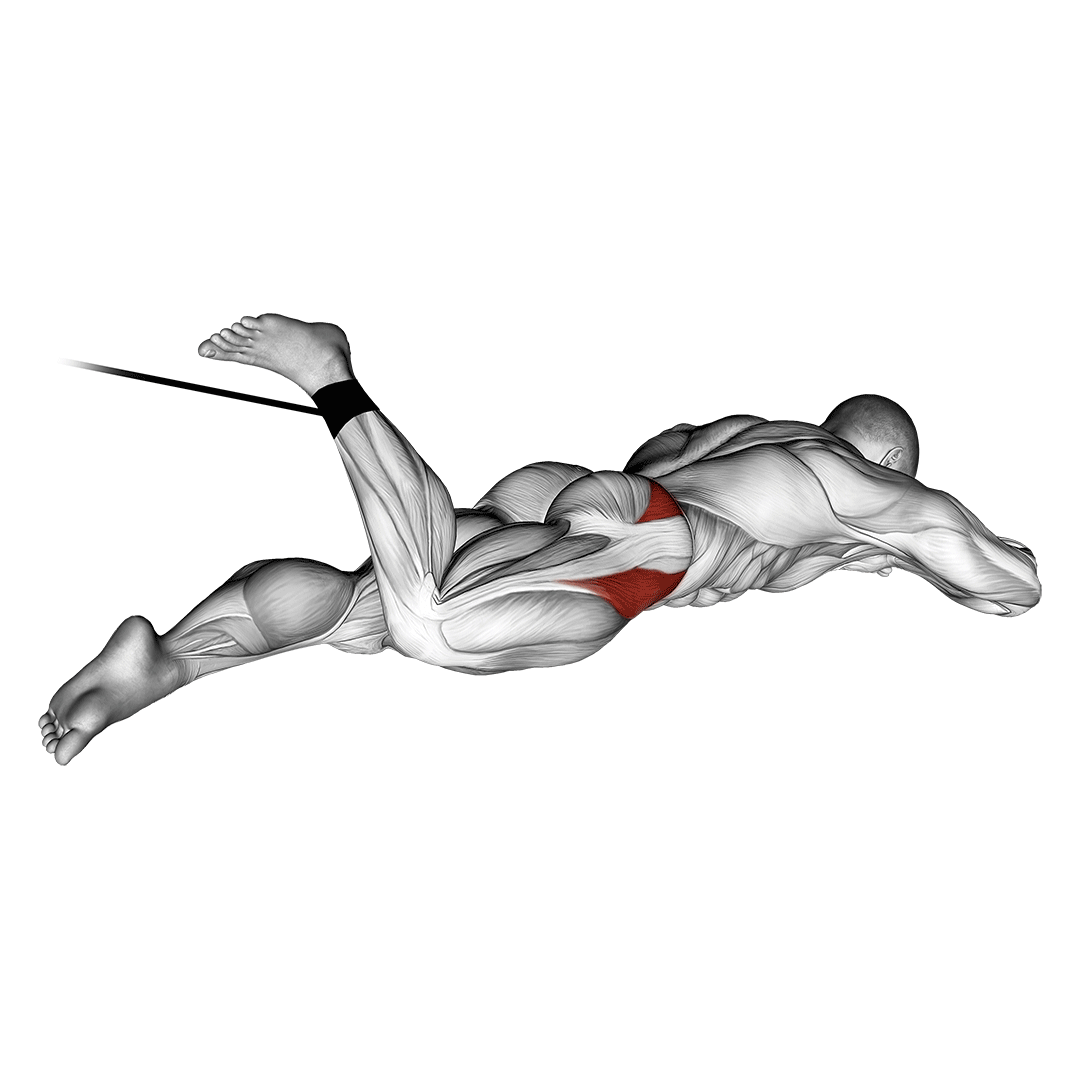Transform Your Glutes with Band Lying Hip Internal Rotation effectively targets the gluteal muscles while enhancing hip flexibility and strength. This exercise focuses on the gluteus maximus, medius, and minimus, along with the hip rotators. Engaging these muscles improves hip stability, promotes better posture, and reduces the risk of lower back and knee injuries.
For optimal results, incorporate this exercise into your lower-body routine 2-3 times a week, using a resistance band with appropriate tension. Begin by lying on your back with your knees bent, a looped resistance band positioned just above your knees. Keep your feet hip-width apart, then let your knees fall outward against the band’s resistance. Engage your glutes and core as you rotate one hip inward, holding the contraction briefly before returning to the starting position.
Ensure a proper warm-up to prepare your muscles and focus on controlled movements to maintain quality in each repetition. To progress, adjust the band resistance as you get stronger. Include this exercise for a comprehensive approach to building stronger, more resilient glutes and enhancing overall lower-body performance.
How to Do a Band Lying Hip Internal Rotation

Starting Position:
- Lie on Your Back: Begin by lying flat on your back on a comfortable exercise mat.
- Position the Band: Place a resistance band around your thighs, just above your knees.
- Bend Your Knees: Bend your knees so that your feet are flat on the ground, hip-width apart.
- Engage Core Muscles: Gently draw your belly button toward your spine to engage your core muscles.
Execution Steps:
- Let Knees Fall Outward: Keep your feet planted and slowly let your knees fall outward against the resistance of the band, feeling a gentle stretch in your inner thighs.
- Internal Rotation: Engage your glutes and core as you internally rotate your right hip, bringing your right knee toward the center of your body while keeping your left knee stable.
- Hold the Contraction: Hold the internal rotation for 1-2 seconds, focusing on the contraction in your glute muscles.
- Return to Start: Slowly return your right knee to the starting position, maintaining control against the band’s resistance.
- Alternate Sides: Repeat the movement with your left hip, bringing your left knee toward the center while keeping your right knee stable.
- Complete Repetitions: Continue alternating sides for the desired number of repetitions, typically 10-15 reps per side.
Breathing Pattern:
Level Up Your Fitness: Join our 💪 strong community in Fitness Volt Newsletter. Get daily inspiration, expert-backed workouts, nutrition tips, the latest in strength sports, and the support you need to reach your goals. Subscribe for free!
- Inhale as you prepare and let your knees fall outward.
- Exhale as you internally rotate your hip and engage your glutes.
Common Mistakes
Avoid these common errors to ensure you get the most out of the exercise and reduce the risk of injury:
- Not Engaging the Core: Failing to engage your core can lead to instability. Solution: Consciously tighten your abdominal muscles throughout the movement to maintain stability and proper form.
- Allowing the Feet to Shift: Moving your feet apart or letting them lift off the ground compromises form. Solution: Keep your feet firmly planted and hip-width apart, pressing gently into the floor for stability.
- Inconsistent Speed: Performing the movement too quickly reduces muscle engagement. Solution: Focus on slow, controlled motions, taking 2-3 seconds for each phase of the movement to maximize effectiveness.
- Rotating Too Far: Over-rotating can strain the hip joint. Solution: Rotate only as far as comfortable without pain, aiming for a range of motion that allows you to feel the glute contraction without discomfort.
- Neglecting Proper Alignment: Letting the pelvis tilt or the lower back arch reduces effectiveness. Solution: Keep your pelvis neutral and your lower back pressed gently into the mat to maintain proper alignment.
- Neglecting the Other Side: Focusing on one side can lead to muscle imbalances. Solution: Ensure you perform equal repetitions on both the right and left sides for balanced muscle development.
Benefits
Incorporating the Band Lying Hip Internal Rotation into your routine offers several advantages:
- Strengthens Glute Muscles: Specifically targets the gluteus medius and minimus, essential for lateral movement and stability.
- Enhances Hip Stability: Improves the strength of hip stabilizing muscles, reducing the risk of injuries during activities like running or jumping.
- Improves Core Engagement: Requires activation of the core muscles, leading to better overall stability and balance.
- Promotes Better Movement Patterns: Reinforces proper hip mechanics, aiding in correcting muscle imbalances and improving posture.
- Increases Hip Flexibility: The controlled internal rotation enhances flexibility and range of motion in the hip joint.
- Prevents Lower Back Pain: Strengthening the glutes and hips can alleviate stress on the lower back by promoting proper alignment and movement.
- Enhances Athletic Performance: Beneficial for athletes by improving agility, speed, and power through stronger gluteal muscles.
Exercise Variations
Alternative Exercises
Safety Precautions
When performing the Band Lying Hip Internal Rotation exercise, it’s essential to prioritize safety to prevent injuries and maximize effectiveness.
Level Up Your Fitness: Join our 💪 strong community in Fitness Volt Newsletter. Get daily inspiration, expert-backed workouts, nutrition tips, the latest in strength sports, and the support you need to reach your goals. Subscribe for free!
Warm-Up:
- Start with a Warm-Up: Engage in light cardio or dynamic stretching for 5-10 minutes to increase blood flow and prepare your muscles.
Equipment Check:
- Inspect the Resistance Band: Ensure the band is free of tears or defects that could cause it to snap during use.
- Choose Appropriate Resistance: Select a band that offers resistance suitable for your strength level without compromising form.
Proper Form:
- Maintain Neutral Spine: Keep your lower back pressed gently into the mat to avoid arching.
- Controlled Movements: Perform the exercise slowly to maintain control and reduce the risk of injury.
- Avoid Jerky Motions: Smooth, deliberate movements enhance muscle engagement and protect joints.
Listen to Your Body:
- Stop if You Feel Pain: Discomfort or sharp pain is a signal to stop the exercise immediately.
- Modify if Necessary: If the standard version is too challenging, reduce the band’s resistance or limit the range of motion.
- Consult a Professional: If you have existing hip or lower back issues, seek advice from a healthcare provider or certified trainer before starting.
Environment:
- Safe Exercise Space: Ensure the area is clear of obstacles and has a non-slip surface.
- Use a Mat: A cushioned exercise mat provides support and reduces pressure on your spine and hips.
Hydration and Attire:
- Stay Hydrated: Drink water before, during, and after your workout.
- Wear Proper Attire: Comfortable clothing that allows full range of motion; avoid overly loose garments that could get caught in the band.
Final Thoughts
The Band Lying Hip Internal Rotation is an effective exercise for strengthening the gluteal muscles and improving hip stability. By incorporating this movement into your regular fitness routine, you can enhance lower-body strength, prevent injuries, and improve overall athletic performance.
Remember to focus on proper form, controlled movements, and listen to your body’s signals. As you progress, gradually increase the band’s resistance to continue challenging your muscles and achieving your fitness goals.








